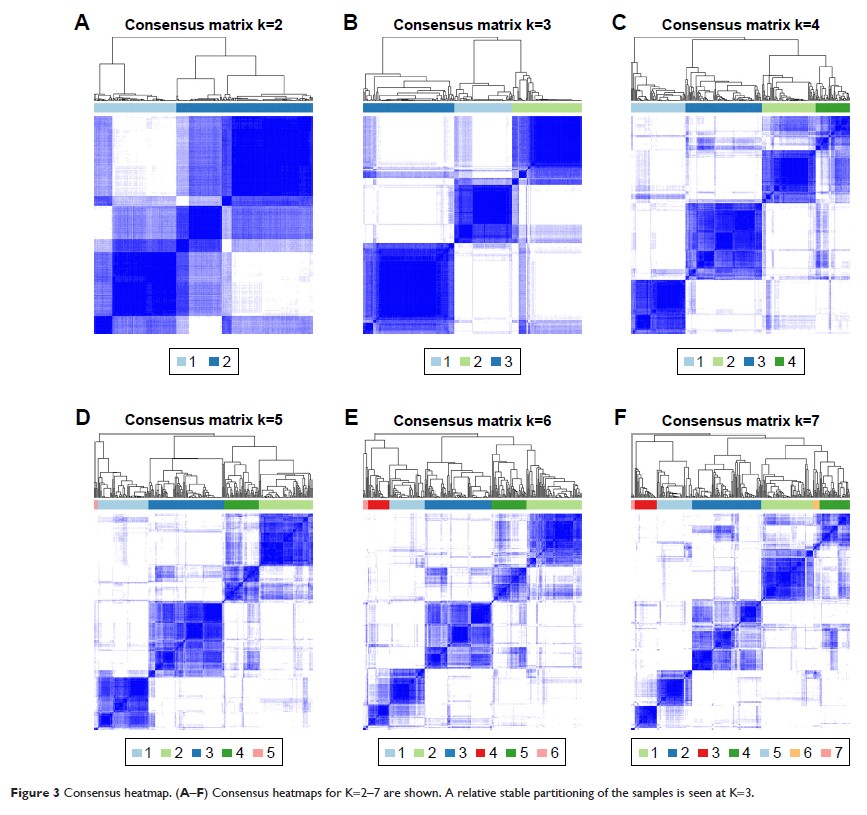108384
论文已发表
注册即可获取德孚的最新动态
IF 收录期刊
- 3.4 Breast Cancer (Dove Med Press)
- 3.2 Clin Epidemiol
- 2.6 Cancer Manag Res
- 2.9 Infect Drug Resist
- 3.7 Clin Interv Aging
- 5.1 Drug Des Dev Ther
- 3.1 Int J Chronic Obstr
- 6.6 Int J Nanomed
- 2.6 Int J Women's Health
- 2.9 Neuropsych Dis Treat
- 2.8 OncoTargets Ther
- 2.0 Patient Prefer Adher
- 2.2 Ther Clin Risk Manag
- 2.5 J Pain Res
- 3.0 Diabet Metab Synd Ob
- 3.2 Psychol Res Behav Ma
- 3.4 Nat Sci Sleep
- 1.8 Pharmgenomics Pers Med
- 2.0 Risk Manag Healthc Policy
- 4.1 J Inflamm Res
- 2.0 Int J Gen Med
- 3.4 J Hepatocell Carcinoma
- 3.0 J Asthma Allergy
- 2.2 Clin Cosmet Investig Dermatol
- 2.4 J Multidiscip Healthc

通过 miRNA 表达进行乳头状肾细胞癌的分子亚型分类
Authors Yu C, Dai D, Xie J
Received 7 November 2018
Accepted for publication 29 January 2019
Published 29 March 2019 Volume 2019:12 Pages 2311—2322
DOI https://doi.org/10.2147/OTT.S193808
Checked for plagiarism Yes
Review by Single-blind
Peer reviewers approved by Dr Colin Mak
Peer reviewer comments 2
Editor who approved publication: Dr Sanjay Singh
Background: Renal
papillary cell carcinoma (KIRP) is a relatively rare renal malignancy. Although
KIRP subtyping about clinical relevance has been defined, there have been
scarce number of studies on the molecular characteristics of KIRP subtypes.
Method: In this
study, a independent samples t-test was used to identify differentially expressed
(DE) miRNAs between tumor and normal samples of KIRP. Meanwhile, we performed
unsupervised clustering using DE miRNA expression data to analyze molecular
characteristics of KIRP. The Partitioning Around Medoids clustering approach
was used to identify molecular subtypes. The cumulative distribution function
(CDF), proportion of ambiguously clustered pairs (PAC), principal component
analysis (PCA) and consensus heatmaps were used to assess the optimal subtypes.
In the differential molecular subtypes, we performed an integrated analysis of
survival, DE genes, biological function and somatic mutations on the cohort of
KIRP patients from The Cancer Genome Atlas.
Results: From
solutions with 2, 3, 4, 5, 6 and 7 clusters we selected three KIRP molecular
subtypes after assessing PCA, PAC, CDF and consensus heatmaps. We found that
the three subtypes are associated with different overall survival and molecular
characteristics. Compared with subtype1 and subtype3, subtype2 had a better
prognosis in KIRP patients. After exploring their signaling pathways and
biological characteristics, we identified the significantly enriched KEGG
pathways and Gene Ontology terms for the three subtypes. The distribution of
PARD6B, SETD2, STAG2, CUL3, TNRC18, LRBA, IGSF9B and DUNC1H1 mutations differed
between the subtypes.
Conclusion: We
performed unsupervised clustering using differentially expressed miRNA
expression data and described the three KIRP molecular subtypes. The three
subtypes differed in overall survival, molecular characteristics and gene
mutation frequency.
Keywords: renal
papillary cell carcinoma, unsupervised clustering, molecular subtype, prognosis
